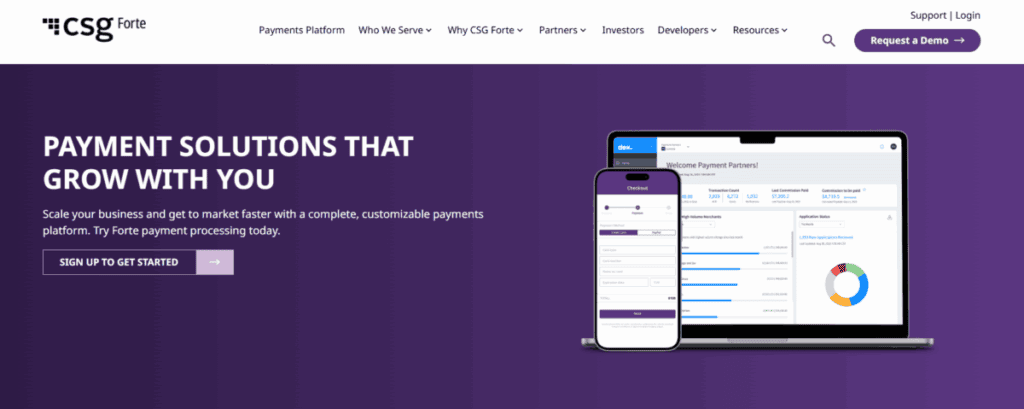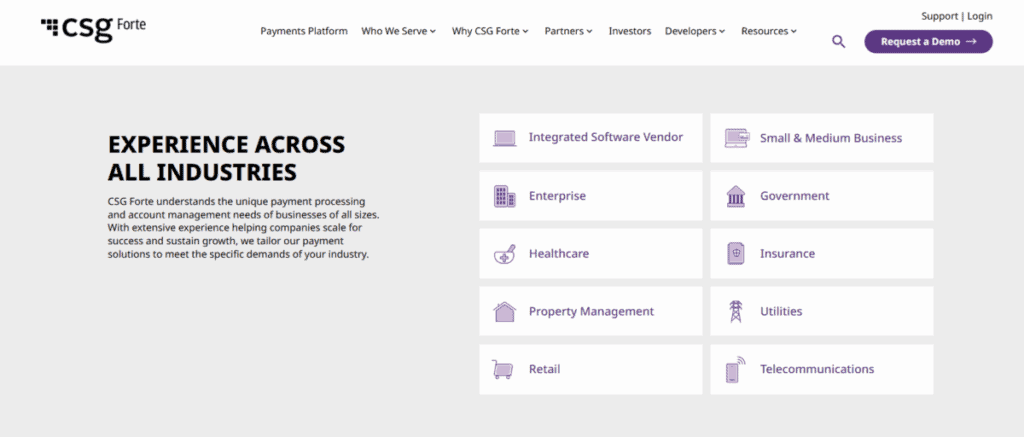
Forte Payment Systems Review
- 27th May, 2025
- | By Linda Mae
- | Reviews
Forte Payment Systems is a U.S.-based payment processor that primarily serves government agencies, utilities, healthcare providers, and service-based businesses. Founded in 1998 and acquired by CSG in 2018, Forte has evolved into a flexible and secure platform offering both ACH and card-based payments. Unlike processors that focus on retail and e-commerce, Forte emphasizes compliance-heavy and recurring billing environments. Its solutions span online portals, mobile devices, call centers, and in-person payment systems. Lets read more about Forte Payment Systems Review.
Cloud-based architecture is supported by the company’s infrastructure, which makes it flexible and scalable for mid-sized to enterprise-level businesses. Tokenization, digital invoicing, recurring billing tools, custom payment workflows, and support for multiple payment types are all provided by Forte. These consist of contactless payments, eChecks, debit cards, and credit cards. Via strong APIs, it also enables customers to incorporate payment processing into proprietary platforms.
Forte might not be the ideal choice for every merchant, even with its advanced features. The setup may be more complicated than necessary for plug-and-play systems or smaller businesses. However, Forte offers a reliable and highly configurable solution for businesses that value compliance, data security, and flexibility across multiple payment channels.
Core Payment Features and Capabilities | Forte Payment Systems Review
Forte offers a comprehensive suite of payment processing capabilities designed to accommodate a wide range of industries. Its platform enables acceptance of ACH payments, credit and debit card transactions, and eChecks. One of its core strengths is its ability to process both one-time and recurring payments through a single platform, supporting web-based, in-person, and mobile channels.
ACH processing is a central offering and is particularly useful for industries such as government, education, and healthcare. It allows for direct bank transfers at a lower cost than card-based transactions. This makes Forte a cost-effective choice for businesses handling large volumes of recurring payments. In addition to ACH, Forte’s platform supports real-time credit and debit card payments and provides tools for managing refunds and chargebacks.
Digital wallet support includes Apple Pay and Google Pay, which helps cater to modern consumer expectations. Businesses can use Forte to manage invoicing and automatically send reminders to customers for due payments. It also enables tokenization of sensitive payment data, ensuring security while facilitating repeat transactions without re-entering card details.
The platform offers optional modules for account verification and fraud prevention, giving businesses better control over transaction integrity. Combined, these features make Forte well-suited for organizations that need flexibility and scalability in how they accept and manage payments.
Virtual Terminal and Mobile Solutions
Forte provides a virtual terminal that enables businesses to process payments without needing a physical point-of-sale system. This feature is particularly useful for service industries, call centers, and remote billing environments. Users can manually enter payment details, issue refunds, store customer information securely, and set up recurring transactions all within a centralized dashboard.
There is no need for extra hardware or downloads because the virtual terminal is browser-based. Although there may be a small learning curve for new users during the initial setup, its interface is generally simple. The terminal easily integrates with Forte’s back-end tools, such as automated billing and customer vault, and it accepts both ACH and card payments.
Forte provides mobile applications that enable payment processing on tablets and smartphones. These apps are good choices for tradespeople, nonprofits holding donation events, and on-site service providers because they support card readers for swiped transactions. Reporting access, customer lookup, and receipt generation are additional mobile features.
While Forte’s mobile capabilities are not as flashy or retail-oriented as Square or Clover, they provide enough utility for field-based businesses or those with moderate in-person payment needs. What stands out is the consistency across its virtual, mobile, and web-based platforms, allowing businesses to manage all transactions in a unified ecosystem.
Developer Tools and API Integration
Forte’s developer resources are one of its standout features, especially for businesses that need custom integration capabilities. The platform offers RESTful APIs that allow seamless embedding of payment processing into web apps, mobile apps, or proprietary business systems. This is particularly useful for software vendors, SaaS providers, and large enterprises looking to build fully branded payment experiences.
The API documentation is publicly available and fairly well organized. It covers everything from basic transaction processing to advanced functions such as account validation, recurring billing setup, and webhook notifications. Developers also get access to a sandbox environment for testing, which helps reduce errors during live deployment.
Forte supports client-side encryption and tokenization, allowing secure transmission of sensitive data. This makes it easier for developers to meet compliance requirements while building flexible payment workflows. SDKs are also available for popular languages and platforms, including JavaScript, PHP, and .NET.
Another strength is the modular design of Forte’s APIs. Businesses can use only the components they need without having to overhaul their existing systems. However, companies without technical resources may find the API-centric model overwhelming. For them, Forte’s virtual terminal or hosted payment pages might be a better starting point.
Overall, the developer tools reinforce Forte’s positioning as a flexible and scalable solution for businesses with unique payment processing requirements.
Compliance and Security Standards
Security and compliance are central to Forte’s platform. The company adheres to PCI-DSS Level 1 standards, which is the highest level of certification in the payment industry. This ensures that merchants using Forte benefit from industry-standard encryption, secure data storage, and secure transmission protocols.
It employs tokenization to replace sensitive cardholder data with randomly generated tokens. This helps minimize the risk of data breaches while allowing for secure recurring billing and customer data storage. Transactions are also monitored through fraud detection tools, which can flag suspicious behavior and trigger alerts or blocks.
Forte provides built-in tools to manage requirements like OFAC screening and account validation, and it supports NACHA rules for ACH payments in terms of regulatory compliance. For businesses in regulated industries like government, healthcare, and financial services, these characteristics are particularly important. In order to help reduce fraud, the platform offers optional modules for AVS, CVV checks, and velocity controls. Forte also helps businesses keep thorough records for regulatory reporting by logging all activity for audit and compliance tracking.
For businesses that must prioritize data integrity and compliance above all else, Forte provides a reliable framework. However, these features may be more than what is necessary for casual sellers or low-risk industries.
Pricing Structure and Transparency
Forte does not follow a one-size-fits-all pricing model. Instead, its pricing tends to be customized based on the client’s industry, processing volume, risk level, and specific features required. This makes it somewhat difficult to find published rates, which can be a drawback for small businesses seeking transparent and straightforward pricing.
Generally, Forte charges fees for credit and debit card processing, ACH transactions, and add-on services like fraud prevention or account verification. There may also be monthly gateway or statement fees, depending on the chosen setup. ACH transactions tend to be more cost-effective, often priced at a flat rate per transaction.
While customized pricing can benefit large organizations by tailoring costs to usage, it can create uncertainty for smaller businesses during the decision-making phase. Some users have reported occasional additional fees for features such as chargeback management or next-day funding, though these can often be negotiated during onboarding.
Forte’s sales representatives usually provide detailed quotes after assessing a client’s needs. While this allows for flexibility, businesses looking for plug-and-play transparency may prefer providers that list pricing openly on their website. Overall, Forte’s pricing structure supports scalability and customization but may not suit every business’s appetite for predictability or ease of entry.
Industry Applications and Use Cases
Forte is best known for serving sectors that require strict compliance and recurring billing workflows. These include government agencies, healthcare providers, educational institutions, property managers, and utilities. Its emphasis on ACH processing, secure billing, and robust reporting tools makes it a strong choice for industries handling high transaction volumes or sensitive customer data.
Government entities often use Forte for tax collection, permitting fees, and utility billing. Its tools for account validation and fraud prevention align with regulatory requirements. Healthcare providers benefit from recurring billing and HIPAA-compliant data handling through integrated third-party solutions. Educational institutions use the platform for tuition payments and donations.
Forte’s features for managing donations and recurring billing are also beneficial to nonprofits and membership-based organisations. It is flexible enough to accommodate different business models because it accepts both one-time and subscription-style payments.
However, Forte might not be as suitable for the restaurant and retail industries. The platform is devoid of the POS hardware and user-friendly interfaces that are popular with businesses that deal with customers on a regular basis. Nevertheless, because of its adaptability, Forte might still be useful for companies that offer B2B services or hybrid models. To put it briefly, Forte excels in industries where multi-channel support, customisation, and compliance are essential rather than optional.
Reporting, Dashboards, and Analytics
Forte offers robust reporting and analytics tools that give businesses comprehensive visibility into their transactions and financial health. The user dashboard provides access to real-time data, customizable reports, and historical transaction logs. This is particularly beneficial for organizations managing complex billing cycles or regulatory reporting.
Reports can be filtered by payment type, transaction status, customer ID, and more. This flexibility allows users to dig into specific data points, whether for daily reconciliation or long-term planning. Export options are available in various formats, including CSV and PDF, which helps when integrating with accounting or ERP systems.
The system also offers automated settlement reporting and batch summaries. Users can set up scheduled reports to be delivered to specific team members or departments, reducing manual workload. For businesses that deal with a high volume of transactions, this feature helps in catching discrepancies or trends early.
Forte’s analytics are geared more toward operational efficiency than marketing insights. You won’t find advanced consumer behavior tracking here, but you will get clear, reliable financial data. This makes the platform well-suited for accounting teams and financial administrators. Although the interface may appear slightly dated compared to newer platforms, the functionality is solid. Businesses that need detailed financial reporting rather than surface-level dashboards will appreciate the depth offered here.
Customer Support and Onboarding
Forte offers multiple channels for customer support, including phone, email, and an online support portal. Response times are generally reasonable, and most users report positive experiences with the technical support team, particularly during the integration and onboarding stages.
Usually, a setup procedure that includes account configuration, API access, and optional training is walked through with new users. Additionally, Forte offers a knowledge base and documentation centre that addresses platform usage, compliance procedures, and technical integration. For daily tasks, this lessens the need for assistance.
Forte assigns account managers to companies with complicated payment requirements, serving as a single point of contact for setup and follow-up enquiries. This can be a great advantage for businesses that need customised processes or plan for expansion. It might be more difficult for users without dedicated account representatives to obtain prompt solutions for specialised problems, though. Furthermore, there is little support for weekends and after-hours, which might be a problem for companies that operate outside of regular business hours.
Overall, Forte’s support infrastructure is reliable and informative, though not as instantly accessible or chat-focused as some newer competitors. It performs best in environments where a more structured, process-oriented support approach is acceptable.
Pros, Cons, and Final Verdict
Forte Payment Systems offers a robust, scalable payment platform that shines in compliance-driven environments. Its strengths lie in its ACH capabilities, API flexibility, and industry-specific tools for recurring billing and secure data management. Businesses in sectors like government, healthcare, education, and utilities are likely to find Forte a strong match for their needs.
The platform is appropriate for businesses with internal IT resources due to its extensive developer support and customisable nature. Businesses handling sensitive financial or personal data can feel more secure thanks to its PCI-compliant and secure infrastructure.
For smaller merchants or those seeking a simple and quick setup, the platform might be too complex. Businesses that require cost predictability may also be put off by unclear pricing. Furthermore, despite being functional, its interface might seem outdated in comparison to rivals who prioritise user experience.
To sum up, Forte is not a universally applicable solution. For businesses that place a high priority on integration, customisation, and compliance, it is an excellent payment processor. Forte provides a strong, enterprise-grade solution for those requirements.
FAQs
Q1: Is Forte Payment Systems suitable for small businesses?
Forte can work for small businesses but is better suited for mid-sized and large organizations due to its customization options and complexity. Small businesses may find it more than they need unless they have recurring billing or ACH requirements.
Q2: Does Forte offer recurring billing and invoice management?
Yes, Forte has strong support for recurring billing, invoicing, and subscription payments. These tools are especially useful for service providers, nonprofits, and educational institutions.
Q3: How secure is Forte for processing payments?
Forte is PCI-DSS Level 1 compliant and uses tokenization, encryption, and fraud prevention tools to safeguard transaction data. It is a secure option for handling both card and ACH payments.



